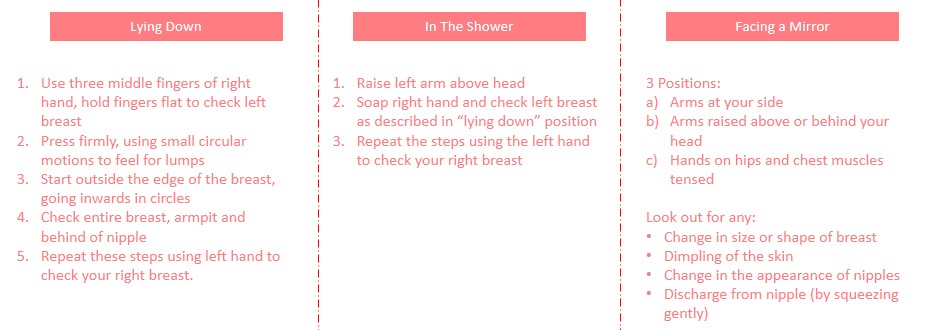Detecting Breast Cancer


CLICK ON IMAGE TO ENLARGE
If you do not routinely conduct breast self examination, there is no better time than the start of Breast Cancer Awareness Month this October!
What is Breast Cancer?
Breast Self-Examination
It is a useful and important screening tool, especially when used in combination with regular physical examinations by a doctor, mammography, and ultrasound. The earlier cancer is detected, the better the chances for treatment and
survival. Therefore, it is recommended that all women incorporate breast self-examination as part of their routine breast cancer screening process. Here are some easy steps that you can follow:  P.S. Breast cancer is not just a woman’s disease. Men can also be diagnosed with breast cancer, presenting the same symptoms as those in women. As men don’t regularly check their breasts, the signs are easier to miss.
P.S. Breast cancer is not just a woman’s disease. Men can also be diagnosed with breast cancer, presenting the same symptoms as those in women. As men don’t regularly check their breasts, the signs are easier to miss.
What if I find a lump?
Firstly, do not panic.
Arrange for a clinical breast examination with a gynaecologist. Also, discuss with your doctor and consider doing a diagnostic mammogram or ultrasound. It’s normal for breasts to feel lumpy, which is due to normal changes in breast tissue. Breast lumps are actually very common, especially in premenopausal women and they usually vary with and go away by the end of the menstrual cycle. However, breast lumps or changes in the breast cannot be ignored either and one should seek medical attention.
Diagnostic Mammograms/Ultrasounds
Be diligent about regular self-exams and yearly clinical exams. Inform your doctor immediately, should there be any changes. If all the tests did not reveal any suspicious issues or are indeterminate, it is sufficient to continue going for the routine screening mammogram once every two years. If any suspicious lumps or nodules are seen on the ultrasound scan or additional mammograms, you would need to go for a breast biopsy to rule out early breast cancer.
Breast Biopsy: What and How?
A biopsy involves the removal of tissues from the breast to test if the cells are cancerous. The cells that are extracted are examined under a microscope and tested to check for the presence of cancerous cells. – If the biopsy
is benign and the lesion is not a high-risk one, continue to conduct routine screening mammogram once in two years or once a year (depending on your age) – If the biopsy shows cancer or other suspicious lesions, you need
to visit a breast surgeon for further treatment For more information on biopsy, please visit this page.
